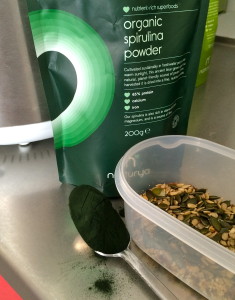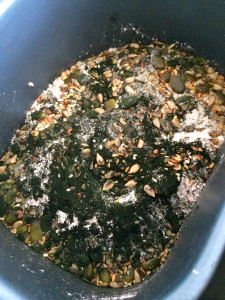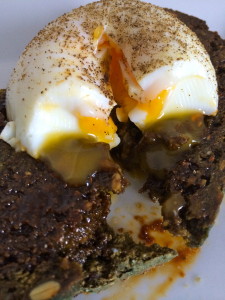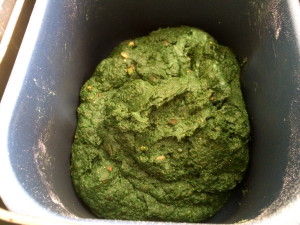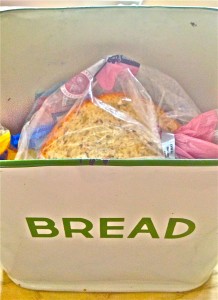The other day I was sitting down to lunch with a few others at a canteen type location and while they all tucked into the catering offerings, I was preparing a lunch for myself that was about to cause some quiet sensation.
The first comment was, ‘@$*!ing hell…! Is that bread moldy!?!’ and it went on from there. Fair dos really as I was smearing cashew butter and avocado onto what looked, for all the world, like a piece of bread currently sporting a lab bacteria experiment. It wasn’t obvs.
It is quite simply my homemade bread as shown in this previous post Awesome Bread…! but this time with spirulina. The added ingredient responsible for the scrunched up noses and suspicious looks!
Quite frankly I’ve taken to adding spirulina to my bread because it’s about the only way I can actually enjoy it! The packaging, along with many websites, extol the virtues (fact) and suggest it is delicious sprinkled and added to a variety of things like smoothies, pasta sauces, stir fries, dips and dressings (fiction). It has a deep earthy taste that turns claggy and bitter in your mouth and smells like weeks old water that a bunch of flowers has sat in or a stagnant pond. This latter is not that surprising when you know it is actually blue-green algae.
Actually, blue-green algae is the more accessible term adopted for what is, in truth, a type of bacteria that grows in water by harnessing the warmth and power of the sun. Merrily it has photosynthesised itself into creation, quietly going about its bacterial business for eons when some bright spark comes along and discovers, what this unicellular ancient mariner knew all along, that it’s a powerhouse of health and goodness.
So, why spirulina?
Good question and one that, as with most things, requires a slightly lengthy answer! Well, I’m not famed for my simple answers am I? And, after all, health is a serious business.
It has been credited with many health benefits – some borne out by research and generally accepted to be true, and others that remain the subject of doubt and debate. As with all things labelled ‘superfoods’ (awful expression) its health benefits are seemingly endless. So, hopefully, it:
- is an all round brilliant anti-oxidant
- helps balance blood pressure and blood sugar levels
- assists in the protection against stroke, cancer and anemia
- helps raise the ‘good’ cholesterol HDL and lower the ‘bad’ cholesterol LDL
- is generally anti-inflammatory especially in cases of allergic rhinitis
- is generally immune boosting and assists the body with fighting auto-immune diseases
- supports and assists healthy gut bacteria function…
…even if it does a little of each of these or simply assists with just one then it’s worth a go, right?
It’s the amount and quality of the protein that gives spirulina it’s reputation – a rare plant based protein that is a complete protein – meaning it contains all the essential amino-acids (called essential because they are vital for the body but cannot be made by the body, unlike non-essentials, so must be provided through the diet). It’s variously reported to be between 65 and 70% protein – which make it one of the highest of all known foods. It could rival eggs as the poster child for complete protein outside an animal product (I might add that a poached egg on this bread is a divine combination – a marriage of the super-proteins!)
It is similarly lauded for its essential fatty acid content. The ratio of Omega 6 to Omega 3 in spirulina is considered ideal. Usually we have too much Omega 6 compared to Omega 3 in our diets but it’s not that either is ‘good’ or ‘bad’ it’s really about the amount of each. They have their own benefits but the source and ratio to each other is the key factor. The ideal Omega 6 to Omega 3 ratio is anywhere from 1:1 up to no more than 4 or 5:1. Spirulina is 1.5:1…!
It has no hard outer cell wall so is easy to digest and is low in fat and sodium but high in protein and packed with vital minerals especially copper and iron, but it has a good dose of others like manganese and potassium too. It has small amounts of just about every nutrient we need. Although high in several key vitamins from the B group its claim to be high in vitamin B12 is seemingly untrue. Long has a search gone on for a plant based vitamin B12 to help the diets of vegetarians and vegans (the best sources of vitamin B12 are animal products) but the truth seems to be that the vitamin B12 in spirulina is what’s known as a pseudovitamin and therefore not effective in humans.
There is (currently) an added feel good factor to spirulina as it has an almost singular reputation of not being detrimental to those communities who harvest it, unlike other fashionable foods like coconut water. It is also being investigated as a way to combat world hunger and malnutrition. That’s no casual statement as its hardy ability to grow just about anywhere and survive just about any conditions, coupled with its host of health benefits and mega protein levels, actually make it seem like a proper contender.
So get adding it to your bread mix because perhaps it does deserve that superfood moniker after all…?
The health benefits of the spelt flour and various seeds used in this bread are all explained in the bread-making article Awesome Bread…!

